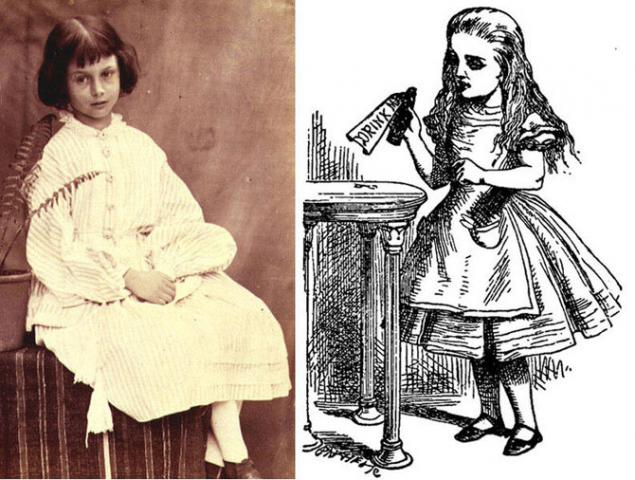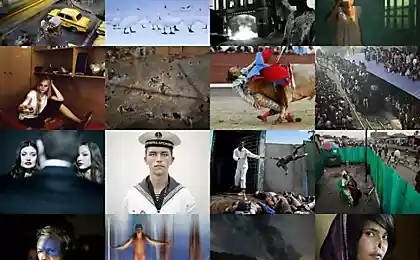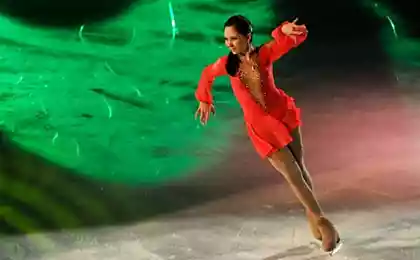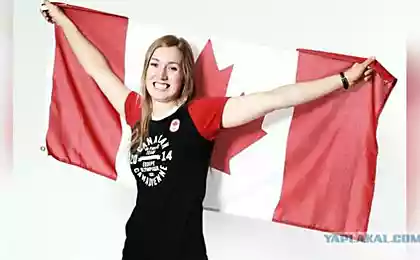1284
As illustrated first edition
History of the illustrations for the first edition of "Alice in Wonderland" - is the real drama of cooperation and struggle between two bright individuals. I think one of them - Charles Lutwidge Dodgson (Carroll's real name is such) you know.
(10 photos)
Via: Sergey Kuriy

1. When, in 1863, he prepodnёs handwritten version of "Alice's Adventures under ground" of his inspirer - girl Alice Liddell, his friends in one voice said - it is necessary to publish a story.

2) August 2, 1865 the first edition of "Alice in Wonderland" with drawings J. Tenniel
Children's fairy tale illustrations required. And they were already available - Notorious hand in the production of family handwritten journals, Dodgson himself illustrated his manuscript. The drawings were quite creative and funny, but were amateurish in nature. Therefore publisher persuaded Charles to find a professional artist.
This professional is a graduate of the Royal Academy of Fine Arts - John Tenniel. In 1840, during a fencing lesson with his father an artist injured and blinded in one eye. After that he was engaged in painting and rarely switched to book drawing. John quickly became famous in this genre, and in 1850 he was invited to work in the satirical magazine "Punch", where he soon became a leading cartoonist.
When prompted to illustrate "Alice", Tenniel long doubted. As a result, it seduced by the fact that a lot of small animals in a fairy tale, which draw very fond of John.
But it was necessary to start work as an artist immediately regretted that he had contacted Dodgson. The author of "Alice", was known to be very scrupulous and pedantic nature. Another illustrator Carroll - Harry Furniss - recalled how Tenniel indignantly said, "Dodgson impossible! This zaznayku Mentor can not sustain more than a week! ". The fact that the author wanted to fully control the process and finding fault with every detail drawings (for example, asked crinoline dresses Alice a little smaller). Tenniel, in turn, said that he was, in fact, an artist, and he has the vision. The above-mentioned Furniss recalled how Dodgson admitted that of the 92 drawings Tenniel to "Alice" he liked only one. However, I think it was said in the hearts ...
Alice of life and Alice from the book. With a photographic memory, Tenniel almost never painted from life

3. How else to explain that three years after such a grueling cooperation Dodgson dare to revert to Tenniel - now with a request to illustrate "Alice in Wonderland"?
To create an image using a portrait of the Duchess of Tenniel Quentin Matsys "The Ugly Duchess" (left), in which he captures the real Duchess Marguerite nicknamed "Maultash" ("mouth purse»)
4. Painter long disagreed, so Dodgson even going to pay out of pocket publisher "Punch" that it freed Tenniel from work for 5 months. As a result, Tenniel agreed, but stipulated that - over the "Looking Glass" it will work slowly - in their spare time. "Do not hurry," lasted for almost three years - out of print "Wonderland" came out only at the end of 1871.
Here are some examples of what a heated debate raged between the artist and the author. It all started already with the appearance of the heroine. As you know, the book Alice in Tenniel came at all unlike the real prototype. If the daughter of the rector Liddell had black hair and a haircut "square" that Tenniel drew a long-haired blonde doll with not a child a serious look.
"Conducted for the crown of mortal combat with the Lion Unicorn ...»

5. Carroll tried to influence the process and sent to the artist photo and another of his little friends - Mary Hilton Badcock. What Tenniel indignantly replied that he just did not need to see a model for drawings, as Carroll - multiplication table to solve problems. Carroll, in turn, believed that Tenniel overplayed their hand, and Alice came out of proportion - with a large head and short legs.
But Tenniel could insist on. For example, he refused to change the appearance of the White Knight, when Carroll demanded to remove at that mustache ("He's not an old man!"). The request Carroll had his own personal reason - because the image of the Good Knight absurd inventor he parodied himself. Tenniel decided to teach a lesson "zaznayku Mentor", and also drew a knight as a cartoon ... but that's a caricature of himself, mother.
Is easy to see that the image of the White Knight (right) Tenniel made a caricature of himself (left - a self-portrait)

6. While working on "Through the Looking Glass," the artist could afford to intervene even in the holy of holies - the author's text. So, he convinced Carroll tale remove from a whole chapter to "Bumblebee in a wig", saying: "It's beyond art ... Do not think for being rude, but I must confess," bumblebee "the head I did not attractive and I do not see how we can illustrate it" .
So, in the crucible of self-love, is born some of the best (and certainly canonical) Illustration to the tale of Dodgson-Carroll. However, one of the first reviews of "Wonderland" they are not appreciated, "Mr. Tenniel illustrations rude, gloomy, clumsy, despite the fact that the artist is extremely resourceful and, as always, almost majestic."
Tenniel drawings were carved boxwood engravers on boards

7. In the words of the critic had a grain of truth - drawings, indeed, came not for children. But the same and they are fascinating. I remember that when I first saw gloomy and phantasmagoric Tenniel illustration, I immediately felt in fairy tales about Alice some hidden depth.
Even the fact that Tenniel abundantly used here the cartoon techniques, does not spoil anything (a caricature - this is also the grotesque and distorted, so suitable for misrepresentation world Carroll). Thus, in the guises of the Lion and the Unicorn fighting British politicians perceive W. Gladstone (Liberal leader) and B. Disraeli (Conservative leader), which Tenniel repeatedly parodied in "Punch". Some see the face of Disraeli in the person of the train (that is dressed in a paper suit) and even in the Mad Hatter.
Left - caricature Tenniel Disraeli in the magazine "Punch", right - his own Hatter

8. Although about Hatter there are other assumptions. Someone finds the origins of the image of the famous Arnolfini portrait features of the brush by Jan van Eyck. Someone thinks that the prototype Hatter was weird Theophilus Carter, who lived not far from the famous Oxford and Carroll. Carter wore a top hat and was known for the invention of "bed-alarm", which at the right time just dumped sleeping on the floor.
And illustrations have been drawbacks. The first I have already mentioned - "Not Another Teen." But one thing "Not Another Teen" and another thing - unjustified scary. This unnecessarily creepy picture at one Tenniel - "Jabberwocky". I always liked it, but putting his hand on his head ... I understand that parody Jabberwocky verse Carroll does not correspond to that shown monster that more would be amiss film like "Alien".
Left - picture of Carroll manuscript, right - Tenniel illustration from the book

9. "O fear the Jabberwocky, son! ..." Fig. J. Tenniel

10. Carroll generally like to remove this illustration from the book, but on the basis of a survey carried out among friends agreed: Figure leave, but removed from the frontispiece. As a result, the frontispiece has taken a more appropriate picture of Alice and the White Knight.
No wonder that Tenniel drawings have become classics that will inspire many illustrators of "Alice." Tenniel live on for a long life (93 years), but will never be a picture book. He wrote: "Strange to say, after the" Looking Glass "I completely lost the ability to draw book illustrations, and despite the most tempting offers, nothing has since been done in this genre».
That was enough. The man who painted more than 2 thousand cartoons in "Punch" will remain in the memory of the people, especially the drawings to the "Alice" over which he had long suffered.
In 1890 was published "Alice for Children", where figures were little changed Tenniel and painted under his control

Source:
(10 photos)
Via: Sergey Kuriy

1. When, in 1863, he prepodnёs handwritten version of "Alice's Adventures under ground" of his inspirer - girl Alice Liddell, his friends in one voice said - it is necessary to publish a story.

2) August 2, 1865 the first edition of "Alice in Wonderland" with drawings J. Tenniel
Children's fairy tale illustrations required. And they were already available - Notorious hand in the production of family handwritten journals, Dodgson himself illustrated his manuscript. The drawings were quite creative and funny, but were amateurish in nature. Therefore publisher persuaded Charles to find a professional artist.
This professional is a graduate of the Royal Academy of Fine Arts - John Tenniel. In 1840, during a fencing lesson with his father an artist injured and blinded in one eye. After that he was engaged in painting and rarely switched to book drawing. John quickly became famous in this genre, and in 1850 he was invited to work in the satirical magazine "Punch", where he soon became a leading cartoonist.
When prompted to illustrate "Alice", Tenniel long doubted. As a result, it seduced by the fact that a lot of small animals in a fairy tale, which draw very fond of John.
But it was necessary to start work as an artist immediately regretted that he had contacted Dodgson. The author of "Alice", was known to be very scrupulous and pedantic nature. Another illustrator Carroll - Harry Furniss - recalled how Tenniel indignantly said, "Dodgson impossible! This zaznayku Mentor can not sustain more than a week! ". The fact that the author wanted to fully control the process and finding fault with every detail drawings (for example, asked crinoline dresses Alice a little smaller). Tenniel, in turn, said that he was, in fact, an artist, and he has the vision. The above-mentioned Furniss recalled how Dodgson admitted that of the 92 drawings Tenniel to "Alice" he liked only one. However, I think it was said in the hearts ...
Alice of life and Alice from the book. With a photographic memory, Tenniel almost never painted from life

3. How else to explain that three years after such a grueling cooperation Dodgson dare to revert to Tenniel - now with a request to illustrate "Alice in Wonderland"?
To create an image using a portrait of the Duchess of Tenniel Quentin Matsys "The Ugly Duchess" (left), in which he captures the real Duchess Marguerite nicknamed "Maultash" ("mouth purse»)
4. Painter long disagreed, so Dodgson even going to pay out of pocket publisher "Punch" that it freed Tenniel from work for 5 months. As a result, Tenniel agreed, but stipulated that - over the "Looking Glass" it will work slowly - in their spare time. "Do not hurry," lasted for almost three years - out of print "Wonderland" came out only at the end of 1871.
Here are some examples of what a heated debate raged between the artist and the author. It all started already with the appearance of the heroine. As you know, the book Alice in Tenniel came at all unlike the real prototype. If the daughter of the rector Liddell had black hair and a haircut "square" that Tenniel drew a long-haired blonde doll with not a child a serious look.
"Conducted for the crown of mortal combat with the Lion Unicorn ...»

5. Carroll tried to influence the process and sent to the artist photo and another of his little friends - Mary Hilton Badcock. What Tenniel indignantly replied that he just did not need to see a model for drawings, as Carroll - multiplication table to solve problems. Carroll, in turn, believed that Tenniel overplayed their hand, and Alice came out of proportion - with a large head and short legs.
But Tenniel could insist on. For example, he refused to change the appearance of the White Knight, when Carroll demanded to remove at that mustache ("He's not an old man!"). The request Carroll had his own personal reason - because the image of the Good Knight absurd inventor he parodied himself. Tenniel decided to teach a lesson "zaznayku Mentor", and also drew a knight as a cartoon ... but that's a caricature of himself, mother.
Is easy to see that the image of the White Knight (right) Tenniel made a caricature of himself (left - a self-portrait)

6. While working on "Through the Looking Glass," the artist could afford to intervene even in the holy of holies - the author's text. So, he convinced Carroll tale remove from a whole chapter to "Bumblebee in a wig", saying: "It's beyond art ... Do not think for being rude, but I must confess," bumblebee "the head I did not attractive and I do not see how we can illustrate it" .
So, in the crucible of self-love, is born some of the best (and certainly canonical) Illustration to the tale of Dodgson-Carroll. However, one of the first reviews of "Wonderland" they are not appreciated, "Mr. Tenniel illustrations rude, gloomy, clumsy, despite the fact that the artist is extremely resourceful and, as always, almost majestic."
Tenniel drawings were carved boxwood engravers on boards

7. In the words of the critic had a grain of truth - drawings, indeed, came not for children. But the same and they are fascinating. I remember that when I first saw gloomy and phantasmagoric Tenniel illustration, I immediately felt in fairy tales about Alice some hidden depth.
Even the fact that Tenniel abundantly used here the cartoon techniques, does not spoil anything (a caricature - this is also the grotesque and distorted, so suitable for misrepresentation world Carroll). Thus, in the guises of the Lion and the Unicorn fighting British politicians perceive W. Gladstone (Liberal leader) and B. Disraeli (Conservative leader), which Tenniel repeatedly parodied in "Punch". Some see the face of Disraeli in the person of the train (that is dressed in a paper suit) and even in the Mad Hatter.
Left - caricature Tenniel Disraeli in the magazine "Punch", right - his own Hatter

8. Although about Hatter there are other assumptions. Someone finds the origins of the image of the famous Arnolfini portrait features of the brush by Jan van Eyck. Someone thinks that the prototype Hatter was weird Theophilus Carter, who lived not far from the famous Oxford and Carroll. Carter wore a top hat and was known for the invention of "bed-alarm", which at the right time just dumped sleeping on the floor.
And illustrations have been drawbacks. The first I have already mentioned - "Not Another Teen." But one thing "Not Another Teen" and another thing - unjustified scary. This unnecessarily creepy picture at one Tenniel - "Jabberwocky". I always liked it, but putting his hand on his head ... I understand that parody Jabberwocky verse Carroll does not correspond to that shown monster that more would be amiss film like "Alien".
Left - picture of Carroll manuscript, right - Tenniel illustration from the book

9. "O fear the Jabberwocky, son! ..." Fig. J. Tenniel

10. Carroll generally like to remove this illustration from the book, but on the basis of a survey carried out among friends agreed: Figure leave, but removed from the frontispiece. As a result, the frontispiece has taken a more appropriate picture of Alice and the White Knight.
No wonder that Tenniel drawings have become classics that will inspire many illustrators of "Alice." Tenniel live on for a long life (93 years), but will never be a picture book. He wrote: "Strange to say, after the" Looking Glass "I completely lost the ability to draw book illustrations, and despite the most tempting offers, nothing has since been done in this genre».
That was enough. The man who painted more than 2 thousand cartoons in "Punch" will remain in the memory of the people, especially the drawings to the "Alice" over which he had long suffered.
In 1890 was published "Alice for Children", where figures were little changed Tenniel and painted under his control

Source:























